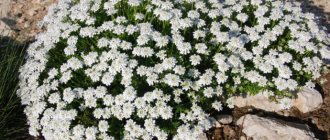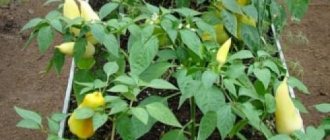The romantic Lily of the Valleys, which blooms in May, is the garden lily of the valley. This name was given to it by the ancient Latins. The plant symbolizes the art of healing. There are many tales and legends about it, supposedly the flower mourns the passing of spring.
The plant blooms at the end of spring in no more than two weeks. It does not grow higher than 30 centimeters. The leaves are wide until the end of June, maintaining a dark green color, then they turn yellow and fade. White bells, collected in tassels of 10 flowers, produce berries containing up to six seeds.
May lily of the valley
Classification of lilies of the valley
This shade-loving plant belongs to the asparagus family. The most popular types of garden lilies of the valley are:
- Albosriata - this variety is characterized by leaves along which small stripes run;
- Flore Plena will have double flowers, collected in inflorescences of 12 or more bells;
- Rosea, hence the name, flowers are soft pink;
- Russian breeders developed the Viktor Ivanovich variety - this is a tall lily of the valley, reaching 50 centimeters.
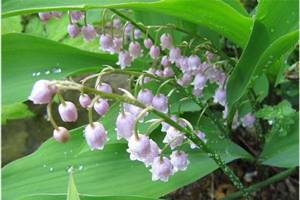
Lily of the valley Rosea
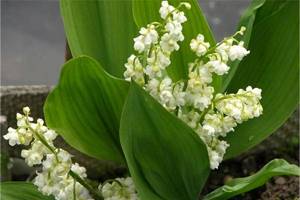
Garden lily of the valley Flore Plena
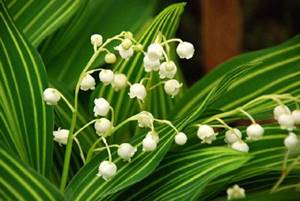
Lily of the valley Albosriata
In ancient Rus', it was believed that the flower was able to drive away people with negative feelings towards the owners of the site. Some surrounded the entire area to be on the safe side. Moreover, the plant is completely unpretentious; even a novice gardener will not experience any difficulties in caring for it.
We grow lilies of the valley
Despite the fact that lilies of the valley in nature grow in the shade of tall trees, this plant feels great in “captivity”, and sometimes looks even better compared to its forest counterparts. You cannot pick lilies of the valley in the forest; they are listed in the Red Book, so the plant is becoming increasingly popular among summer residents and flower growers. People have been growing this plant for a long time; it is believed that already at the beginning of the 16th century, flower growers learned to grow this fragrant and very cute flower.
Despite their pleasant aroma and shy appearance, lilies of the valley are rather insidious flowers. They are considered poisonous and must be handled with care. This type is widely used in medicine, but in cosmetology it is still used with caution.
Garden lily of the valley is an unpretentious plant, but in order for it to please the owner with its beauty and aroma, you need to know something about its preferences.
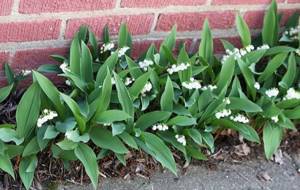
Growing a plant
It is better to choose a place for planting lily of the valley in the shade. It doesn’t like bright sunlight, but you can’t completely shade it either, as you might lose the reason it was planted, beautiful white flowers. Without being critical of the soil, it prefers when it is slightly acidic or neutral. If the acidity is high, treatment with lime 250 grams per 1 m² is necessary . It does not like wetlands and salt marshes; its preparation should begin a year in advance. Before planting flowers, the soil is kept fallow. Organic matter is added, gardeners mix manure, peat and humus in equal proportions.
Read How to determine soil acidity
You can plant lilies of the valley in both spring and autumn. But in the first case, the plant will bloom only after a year. When to replant lilies of the valley is decided by the owner of the site. Therefore, it is better to plant lilies of the valley in the autumn, in September. The exact moment of planting is determined by the color of the foliage; as soon as it turns yellow, you can begin to work.
It is necessary to dig small furrows 10 centimeters deep, maintaining a distance of 25 centimeters between them. When planting is done, 10 centimeters are laid between the flowers. Part of the root and shoots of the plant are placed in the holes. It is necessary that the root goes vertically into the ground. A two-centimeter layer of soil is required on top. The lily of the valley will delight the eye for a decade, but after half the period the plant needs to be replanted.
Video “Garden lily of the valley, what is important?”
Caring for lily of the valley is not difficult. It requires keeping the soil moist, especially during dry periods, which it tolerates easily, but subsequently its flowers become smaller. At the end of summer, it is advisable to feed it with mineral fertilizers, and during the growing season, the plantings are mulched with compost or manure. Lily of the valley loves loose soil and the absence of weeds; they are able to stand up for themselves, displacing other flowers from their territory.
After the flowering period, the plant will decorate the area with lush greenery until the end of summer. As stated earlier, lilies of the valley are invaders by nature, therefore, in order to prevent spread to adjacent areas, for this purpose the flower bed is fenced off; you can use any material, the main thing is to bury the sheets to a depth of about half a meter.
Lily of the valley tolerates winter cold with ease; in most cases it is not covered with anything. But if winter has arrived and there is not enough snow, mulching the soil is required before frost. When frosts appear in the spring, it is worth covering the plantation with polyethylene.
Planting and caring for lilies of the valley
- Planting: from September to early November.
- Flowering: April-May.
- Lighting: partial shade, shadow.
- Soil: moist, rich in organic matter, neutral or slightly acidic.
- Watering: only in abnormally hot times.
- Top dressing: humus or rotted manure, solutions of organic or mineral fertilizers.
- Reproduction: mainly by dividing rhizomes, less often by seeds.
- Pests: sawflies, nematodes, onion borers.
- Diseases: gray vegetable rot, gleosporiasis.
- Properties: lily of the valley is poisonous.
Lily of the valley (lat. Convallaria) is a monotypic or oligotypic (including a small number of species) genus of the Asparagus family. Not so long ago, the lily of the valley flower was classified as a member of the Lily family or allocated to the Lily of the Valley family. The Latin name Lilium convallium, which was given to the plant by Carl Linnaeus, translates as “lily of the valleys.” The Russian name “lily of the valley” most likely came from the Polish language, and this plant is also called rejuvenator, rejuvenator, culprit and shirt. In the wild, lily of the valley is a forest flower; it grows in Europe, Asia and North America in deciduous, pine, mixed forests and floodplain oak forests.
Lily of the valley has been cultivated since the 16th century; in some towns in France, on the first Sunday in May, a lily of the valley festival is held. The healing properties of lily of the valley have been known since time immemorial and are still used in both traditional and folk medicine. Lily of the valley is also in demand in the perfume industry for creating fragrances.
Protection from diseases and pests
The disease that most often affects the plant is gray rot (fungus Botrytis dnerea), which quickly covers the plant with leaves and flowers. To get rid of the infection, watering with fungicides is required.
Lily of the valley is also prone to gleosporium, which causes spots bordered by a red line to appear on the leaves. If the spots are yellowish, this indicates the appearance of dendronema; appropriate solutions of fungicides are also used for treatment.
The plant is suffering and sawfly insects require treatment with insecticides to get rid of them; if this is not done, these insects simply gnaw away the greenery of the plant. The greatest danger comes from the nematode, which affects the root system. It is impossible to cure a plant from it; the only way out is to destroy the diseased flowers. To prevent the disease, marigolds can be planted nearby or the soil must be treated with nematicides.
Where to plant lilies of the valley
Do you remember how lily of the valley (lat. Convallária) grows in natural conditions? This modest creature chooses shaded places somewhere in the hollow between the hills and grows there, creating entire colonies.
The main thing for convalia is a sufficient amount of moisture and diffused light, which it receives under the canopy of trees. Although it is generally unpretentious and, as a rule, feels great even in the shade - under a bench or under a fence. This property allows it to be placed where other garden plants refuse to live and bloom.
Don’t know how to decorate a plot near the house where direct sunlight does not reach at all? Plant several lily of the valley bushes there - in a few years the area will be covered with a green carpet of lily of the valley leaves, which in May will be decorated with delicate fragrant bell flowers on thin stems.
Reproduction of lilies of the valley
In the wild, flowers reproduce by seeds, but in garden conditions their germination rate is quite low and special soil is required. Another disadvantage of the seed method is the late appearance of inflorescences no earlier than 5 years after planting. Therefore, lilies of the valley are propagated in the garden using a vegetative method.
When August arrives, you can begin the process; for this, sprouts are used that are no more than 3 years old. A one-year-old plant will produce only two leaves, but a three-year-old plant will bloom the next year. You can determine when a plant will bloom by its appearance if the bud is half a centimeter in diameter and they have a flat top, they contain inflorescences, thin and sharp ones will allow only leaves to grow.
The instructions are quite simple:
- It is necessary to dig up an adult plant. This is best done with a garden fork. The rhizome, buds and surface roots are removed.
- The dug up lily of the valley is cleared of the ground, the light rhizome should become visible. Divide the plant with your hands or a garden knife. A planting unit includes a piece of root and at least two growth buds; if there are fewer of them, the plant may not take root.
- Divided bushes are planted on prepared soil.
A little about lilies of the valley
Lily of the valley is a perennial herbaceous plant, in its natural environment its height ranges from 15 to 30 cm. Garden lilies of the valley can grow up to 40 - 50 cm. But when they bloom after transplantation is difficult to predict - perhaps in the first year, but more likely, this will happen in the second or third year after transplantation. In the garden, lily of the valley can quite actively “capture territory.” Its root system is branched, thin but strong roots grow shallow from the soil surface in different directions for several meters. Growth buds form on the rhizome - these will be new plants. A clearing of lilies of the valley may turn out to be a single living organism, and a flower carpet of lilies of the valley is a couple of greatly overgrown plants. Most often, from 3 to 5 lower leaves are hidden in the ground; they are scale-like and small. There are 2 or 3 basal leaves, they are oblong, the tip of the leaf is pointed.
The leaves are quite large: length - about 20 cm, and width - about 8 cm. From a large bud located between the leaves, a single stem grows, on the upper part of which a one-sided brush of 5-20 white or light pink flowers will form. They have the shape of a round bell with six teeth and are up to 10 mm in diameter. The vertical rhizome produces leaves annually, and the flowering stem - once every 2-3 years. But since lily of the valley has strong vegetative reproduction, real lily of the valley thickets are formed, it is difficult to track the flowering of an individual specimen, and the erroneous impression may be created that lilies of the valley bloom every year. They bloom within 15-20 days. Lily of the valley fruits are orange-red shiny berries, almost round in shape, 6-8 mm in diameter. They contain from two to eight seeds.
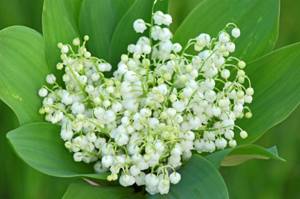
Forcing plants
Lilies of the valley reproduce well at home. You can treat yourself to fresh flowers on New Year's Eve. To achieve this, as soon as the leaves turn yellow, the plants are dug up and divided into planting units; they must be stored until December in a dry place, the temperature should not exceed 4º. In mid-November, the plant can be placed in the refrigerator.
Then, when December begins, the seedlings are placed in warm water with a temperature of 35º, the roots are kept in such water for about 15 hours, some place the seedlings in a thermos.
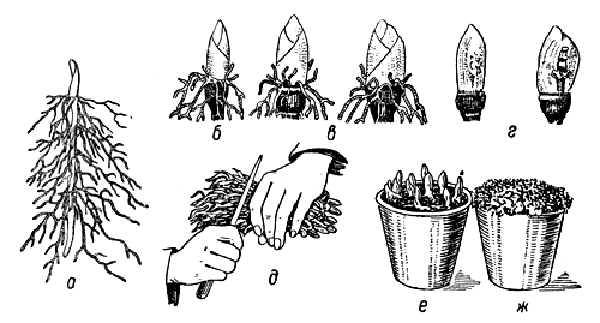
Preparing lily of the valley sprouts for forcing: a - lily of the valley sprout with rhizome, b - growth bud, c - flower buds, d - cuts of flower buds, e - pruning roots before planting, f - planting lily of the valley sprouts in pots for forcing, g - pot with lily of the valley sprouts covered with moss
After the seedlings are planted in pots filled with sawdust, you can use special compounds that retain moisture well. The containers are placed in a dark place, the temperature in it should not be lower than 35º. There they remain until they form buds; the plants are moved to a lighted area, gradually lowering the temperature to room temperature.
Planting lilies of the valley and caring for the garden
When to plant lilies of the valley
If we are talking about when is the best time to plant lilies of the valley in open ground, then any gardener will answer you unequivocally: in the fall, from early September to early November. The most suitable place for them is under trees or bushes, which will create the shade they need for lilies of the valley, preventing the sun from quickly drying out the soil in the area. But remember that these plants still need light, otherwise the area will turn beautifully green, but you won’t see any flowers. And think about how to protect lilies of the valley from the wind.
Lily of the valley requires moist, slightly acidic or neutral soil, rich in organic matter. Let us remind you: in order to reduce the acidity of the soil, lime (200-300 g per 1 m²), humus or peat compost (10 kg per 1 m²), as well as fertilizers: 100 g of superphosphate and 40 g of potassium sulfate per 1 m², and you need to prepare the soil for autumn planting of lilies of the valley in the spring.
Caution won't hurt
Lily of the valley is widespread, they are used in landscape design, and are planted by amateur gardeners. The plant is used by herbalists; it is recommended as a sedative, to stimulate the heart, and as a diuretic.
Despite its wide distribution, the plant is poisonous; you should not self-medicate, especially by making formulations from it. When working with the plant, you must wear gloves. It is imperative to explain to children that beautiful flowers and berries should never be eaten.
Video “Lily of the valley in May”
A plant similar to lily of the valley, but no less healing, is kupena. It is used for cardiovascular diseases, for pain due to rheumatism. But she's not that poisonous. Harvesting must be done in early June.
Lilies of the valley after flowering
Lilies of the valley fade at the beginning of summer, but, having lost their fragrant inflorescences, they decorate the area with their wide dark green leaves for some time. To prevent lilies of the valley from taking over someone else's territory, fence the flowerbed with sheets of slate, digging them 40 cm into the ground.
When autumn comes, start replanting lilies of the valley, if the time has come, and if replanting is not planned this year, forget about lilies of the valley and move on to other flowers - lilies of the valley are frost-resistant, and nothing will happen to them in winter. When spring comes and the snow melts, use a rake to remove last year's dry leaves from the lily of the valley flower bed and wait for the first lilies of the valley to appear.
